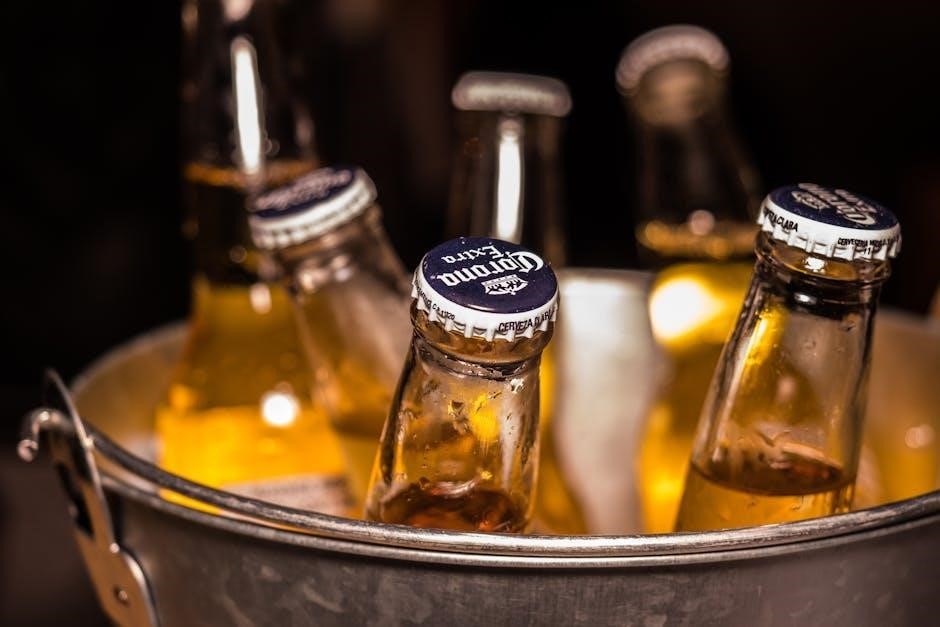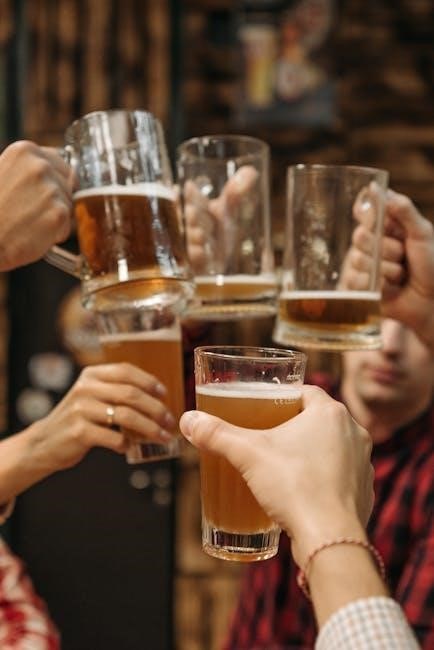Welcome to the world of beer, a timeless beverage with a rich history and global appeal. This guide explores its diversity, from brewing techniques to pairing, helping you navigate its complexity and discover its unique charm.
What is Beer?
Beer is one of humanity’s oldest and most beloved beverages, crafted from simple ingredients like water, grain, hops, and yeast. This versatile drink offers a wide range of flavors, from crisp lagers to rich stouts, and holds significant cultural and historical value worldwide. Beer’s diversity stems from variations in ingredients, brewing techniques, and fermentation processes, resulting in countless styles that cater to every palate. Whether enjoyed casually or savored by connoisseurs, beer’s unique charm lies in its ability to evoke emotions, bring people together, and complement culinary experiences. Its transformation from basic components into a refreshing, flavorful drink continues to captivate enthusiasts, making it a timeless and universal favorite.
Brief History of Beer
Beer is one of humanity’s oldest beverages, with evidence of brewing dating back to ancient Mesopotamia around 6000 BCE. Early civilizations, such as the Egyptians and Sumerians, revered beer for its nutritional value, medicinal properties, and role in religious rituals. The art of brewing spread throughout Europe, where monks refined techniques during the Middle Ages. The Industrial Revolution brought advancements in production, leading to mass distribution and the rise of iconic breweries. Today, beer is a global phenomenon, with craft breweries revitalizing traditional methods and experimenting with innovative flavors. Its rich history reflects cultural evolution, making beer a timeless and universal drink cherished across generations.
Beer Brewing Process
Beer is crafted through a meticulous process involving malting, mashing, boiling, fermentation, and conditioning. Simple ingredients like water, grain, hops, and yeast transform into a refreshing, complex beverage.
Ingredients in Beer
The foundation of beer lies in its four primary ingredients: water, grain, hops, and yeast. Water serves as the base, while grain—typically malted barley—provides fermentable sugars. Hops add bitterness, flavor, and aroma, balancing the sweetness of the malt. Yeast, whether ale or lager-specific, ferments the sugars into alcohol. These components form the core of beer production, with variations in type and proportion creating diverse styles. Additional ingredients like fruits, spices, or herbs are often used in specialty beers to enhance complexity. Understanding these elements is key to appreciating the craftsmanship behind every brew.

Step-by-Step Brewing Guide
Brewing beer is an ancient craft that transforms simple ingredients into a delicious beverage. The process begins with malting, where grains like barley are soaked and dried to activate enzymes. Next, milling crushes the malt into a coarse powder for optimal extraction. Mashing involves steeping the milled grains in hot water to convert starches into fermentable sugars. The resulting liquid, called wort, is then boiled with hops to add bitterness, flavor, and aroma. After boiling, the wort is cooled and transferred to a fermentation tank where yeast is added. Fermentation typically lasts 7-14 days, converting sugars into alcohol. Finally, the beer is conditioned, filtered, and packaged, ready to be enjoyed. Each step requires precision to ensure a high-quality brew.

Types of Beer
Discover the diverse world of beer, featuring ales, lagers, and specialty styles. Each type offers unique flavor profiles, from crisp lagers to robust stouts, catering to every palate.
Ales vs. Lagers
The world of beer is broadly divided into two main categories: Ales and Lagers. Ales are fermented at warmer temperatures, typically between 15°C to 24°C, using top-fermenting yeast, resulting in fruitier, more complex flavors and a shorter fermentation period. Lagers, on the other hand, are fermented at cooler temperatures, around 7°C to 13°C, using bottom-fermenting yeast, producing crisp, smooth, and cleaner profiles with a longer maturation time. This fundamental difference in brewing techniques gives Ales their robust, hoppy characteristics, while Lagers are known for their refreshing clarity. Understanding these distinctions helps beer enthusiasts appreciate the unique qualities of each style and explore the vast variety within these categories.
Popular Beer Styles
Exploring popular beer styles offers a gateway to the diversity of flavors and traditions in brewing. IPAs (India Pale Ales) are renowned for their bold hoppy profiles and aromatic complexity. Stouts and Porters captivate with their dark, roasted malt flavors, often featuring notes of coffee and chocolate. Wheat Beers, such as Hefeweizens, are light and refreshing, perfect for warm weather. Pilsners embody crisp, golden refreshment, while Sour Beers intrigue with their tart, funky characteristics. These styles, among many others, showcase the creativity and craftsmanship of brewers worldwide, offering something for every palate. This guide helps you navigate these popular styles, enhancing your appreciation for the art of beer.
Specialty and Craft Beers
Specialty and Craft Beers represent the pinnacle of innovation and creativity in brewing. These unique brews often feature unconventional ingredients, experimental techniques, or barrel-aging processes, resulting in distinctive flavor profiles. Craft breweries, known for their small-batch production, push boundaries by blending traditional methods with modern twists. From Barrel-Aged Stouts infused with bourbon or coffee to Sour Beers aged with wild yeasts, these beers offer complex and nuanced experiences. Additionally, Belgian Quads and Fruit Lambics showcase the artistry of blending rich malts with fruity or spicy notes. Specialty beers are a testament to the brewer’s craft, inviting enthusiasts to explore bold flavors and discover new favorites. This guide highlights these unique styles, helping you appreciate their craftsmanship and diversity.
Beer and Food Pairing
Beer and Food Pairing is an art that enhances culinary experiences by combining flavors and aromas. Skillfully matching brews with dishes creates harmonious and memorable meals, often surpassing wine pairings.
Basics of Beer Pairing
Mastering the basics of beer pairing involves understanding how flavors and textures complement or contrast. Start by considering the beer’s style, such as crisp lagers or rich stouts, and match them to dishes that enhance their characteristics. Complementary pairing highlights shared flavors, while contrasting pairing creates balance. For example, hoppy IPAs cut through fatty foods, while malty beers pair well with sweet dishes. Aroma and mouthfeel also play key roles. Experiment with pairing beer by its ingredients, like matching citrusy notes in wheat beers with bright, herbal flavors. Personal taste is essential, so explore and find combinations that delight your palate. This foundational approach will elevate your dining experiences and broaden your appreciation for beer’s versatility.
Beer Pairing with Specific Cuisines
Beer pairing with specific cuisines enhances dining experiences by aligning flavors and cultural traditions. For example, crisp lagers complement spicy Mexican dishes, while hoppy IPAs cut through rich Asian flavors. Wheat beers, with their citrus notes, pair beautifully with seafood and salads. Stouts and porters, rich and roasted, match perfectly with hearty European dishes like stews or roasted meats. In Indian cuisine, hoppy beers balance spicy curries, while malty ales complement creamy sauces. Belgian ales, with their complex flavors, are ideal for French or Belgian-inspired dishes. Experimenting with these pairings allows you to explore how beer can elevate the flavors of global cuisines, creating a harmonious and enjoyable meal experience.
Beer Glassware
The right glass enhances beer’s flavor, aroma, and visual appeal. Different styles, like wheat beers in tall glasses or stouts in pint glasses, showcase unique characteristics perfectly.
Importance of Glassware
The right glassware is essential for fully experiencing beer’s aroma, flavor, and appearance. Different glass shapes are designed to enhance specific beer styles, directing aromas and controlling head retention. For instance, wheat beers benefit from tall, narrow glasses that showcase their hazy appearance, while stouts thrive in pint glasses that highlight their creamy texture. The material and design of the glass prevent flavor alteration and preserve carbonation, ensuring an authentic tasting experience. Proper glassware elevates the sensory enjoyment of beer, making it a crucial element for both casual drinkers and connoisseurs. By selecting the right glass, you honor the brewer’s craft and enhance your appreciation of the beer’s unique characteristics.
Common Beer Glasses
Choosing the right glass enhances the beer experience, as different styles highlight specific characteristics. The Pilsner glass is tall and slender, ideal for showcasing crisp, golden lagers. The IPA glass features a wide mouth to emphasize hoppy aromas, while the Stout glass is robust, with a nucleated base to enhance the creamy texture. The Wheat beer glass is tall and narrow, designed to display hazy appearances and retain foam. Goblets and Chalices are large, bowl-shaped glasses perfect for sipping strong, complex beers. Each glass is crafted to optimize aroma, flavor, and visual appeal, ensuring a more immersive tasting experience. Using the correct glassware respects the brewer’s intent and elevates your enjoyment of the beer.

Serving Beer
Serving beer involves more than just pouring; it requires attention to detail to enhance flavor and experience. Proper techniques ensure optimal aroma, temperature, and presentation for every style.
Proper Serving Techniques

Serving beer is an art that enhances its flavor and aroma. Start by selecting the right glassware, as different styles showcase unique characteristics. Pour beer at a 45-degree angle to minimize foam, then straighten to create the perfect head. Ensure the beer is served at the optimal temperature—typically between 40°F and 55°F. Avoid over-handling the glass to prevent warming the beer with your palms. For draft beer, maintain cleanliness and proper carbonation. When serving bottled beer, pour gently to retain carbonation. These techniques preserve the beer’s integrity, ensuring a delightful experience for the drinker. Proper serving elevates both the taste and enjoyment of your favorite brew.
Maintaining Beer Quality
Maintaining beer quality is crucial for preserving its flavor, aroma, and overall character. Store beer in a cool, dark place to prevent light exposure, which can cause skunking. Keep bottles or cans upright to avoid sediment disturbance. Refrigerate beer at consistent temperatures between 40°F and 55°F, depending on the style. Avoid temperature fluctuations, as they can degrade the beer. Handle beer gently to prevent agitation, which can release carbonation. Use clean glassware to ensure no residual flavors or odors affect the taste. For draft beer, maintain clean lines and proper carbonation levels. Regularly check expiration dates and store beer away from strong-smelling foods, as odors can permeate the packaging. Proper storage and handling ensure your beer remains fresh and enjoyable.

Beer Tasting Guide
Discover the art of beer tasting with our comprehensive guide. Learn to appreciate appearance, aroma, and flavor. Tips on glassware, temperature, and palate development for enhanced enjoyment.
How to Taste Beer
Tasting beer is an art that involves engaging your senses. Start by examining the appearance, noting the color, clarity, and head retention. Next, swirl the beer to release its aroma, inhaling deeply to identify floral, hoppy, or malty notes. Take a small sip, letting the liquid coat your tongue to assess flavor and mouthfeel. Pay attention to sweetness, bitterness, and any fruity or roasted undertones. Finally, notice the finish, whether it’s crisp, lingering, or smooth. Use a tasting sheet to document your impressions. Always use proper glassware and serve at the right temperature to enhance the experience. Practice makes perfect—trust your palate and enjoy the journey of discovery!

Beer Flavor Profiles
Beer flavor profiles are as diverse as the styles themselves, offering a wide range of experiences for the palate. From the crisp, refreshing notes of a lager to the bold, hoppy bitterness of an IPA, each beer style has its unique characteristics. Malt-forward brews like stouts and porters often feature rich, roasted flavors, while wheat beers and sours highlight fruity and tart notes. Hoppiness can range from floral and citrusy to earthy and piney, adding depth and complexity. Mouthfeel also plays a role, with some beers being light and effervescent, while others are creamy and full-bodied. Understanding these profiles helps in identifying preferences and exploring the vast world of beer with confidence and appreciation.

Beer and Health
Beer can have both positive and negative health effects. Moderate consumption may offer antioxidant benefits and potential cardiovascular advantages, while overconsumption risks liver damage and weight gain.
Calories in Beer
Beer calorie content varies widely, influenced by alcohol percentage, ingredients, and brewing methods. Light beers typically range from 90-120 calories, while stronger styles like stouts or barley wines can exceed 300 calories. Craft beers, often richer and higher in alcohol, tend to have higher calorie counts. Understanding calorie content is essential for health-conscious drinkers, as regular consumption can impact weight management. Moderation is key, balancing enjoyment with dietary goals. This section provides insights into calorie variations across beer styles, helping you make informed choices while savoring your favorite brews.
Health Benefits and Risks
Beer, when consumed in moderation, offers potential health benefits, such as antioxidants from hops and improved heart health due to moderate alcohol intake. It may also reduce the risk of certain diseases like type 2 diabetes and gallstones. However, excessive consumption can lead to significant health risks, including liver damage, weight gain, and increased chances of chronic diseases like hypertension and certain cancers. Alcohol dependence is another critical concern. Balancing beer consumption with a healthy lifestyle is essential to maximize benefits while minimizing risks. Moderation, defined as up to one drink per day for women and two for men, is key to enjoying beer responsibly.

Beer Culture and Festivals
Beer festivals like Oktoberfest and Portland’s celebrations showcase vibrant culture, uniting enthusiasts worldwide. These events highlight brewing traditions, fostering community and appreciation for craft beer.
Global Beer Festivals
Global beer festivals celebrate the diversity and richness of beer culture, bringing together enthusiasts from around the world. Events like Oktoberfest in Munich, Germany, and Portland’s Waterfront Festival in the U.S., attract millions, showcasing local and international brews. These festivals highlight unique brewing traditions, offering tastings, live music, and food pairings. London’s beer festivals and Belgium’s specialty beer events further exemplify the global appeal of craft beer. Attendees can explore rare styles, meet brewers, and immerse themselves in vibrant atmospheres. These gatherings not only promote beer appreciation but also foster community and cultural exchange, making them a must-visit for any beer enthusiast.
Beer Culture Around the World
Beer culture varies widely across the globe, reflecting local traditions, ingredients, and history. In Belgium, breweries craft unique Trappist beers, while Germany’s Reinheitsgebot ensures purity in brewing. Japan’s sake-inspired beers blend tradition with innovation. India’s growing craft scene incorporates spices like cardamom, creating distinctive flavors. Beer is deeply ingrained in social rituals, from British pubs to Czech beer halls. Annabel Smith, a cask beer expert, highlights its cultural significance. Beer’s role in global cuisine, from pairing with Indian curries to complementing Mexican dishes, showcases its versatility. This cultural diversity makes beer a universal drink, connecting people through shared experiences and flavors, transcending borders and traditions alike.
Your journey through the world of beer is just beginning. With its rich history, diverse styles, and endless pairing possibilities, beer offers endless exploration and appreciation. Cheers to discovery!
Final Thoughts on Beer
Beer is more than a drink; it’s a cultural phenomenon, bridging traditions and innovation. From ancient brews to modern craft creations, its diversity captivates palates worldwide. Whether you prefer crisp lagers or complex ales, each sip tells a story of craftsmanship and passion. Beer’s versatility shines in pairings, enhancing meals and creating unforgettable experiences. Its global festivals and vibrant communities celebrate shared joy and discovery. Embrace the journey, explore styles, and savor the flavors. With endless possibilities, beer invites you to keep learning, tasting, and appreciating its rich legacy. Cheers to the world of beer—where every pint is a new adventure!
Encouragement to Explore More
Your journey into the world of beer is just beginning! With countless styles, flavors, and cultural experiences to discover, there’s always something new to explore. From crisp lagers to bold stouts, and from hoppy IPAs to fruity sours, the diversity of beer ensures endless excitement. Attend festivals, visit breweries, and experiment with food pairings to deepen your appreciation. Don’t hesitate to try new styles or seek recommendations—every pint is an opportunity to learn and enjoy. Whether you’re a casual drinker or a budding connoisseur, the world of beer offers limitless possibilities. So, keep exploring, stay curious, and cheers to the joy of discovery!
